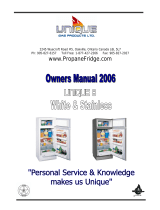
10
12 V DC OPERATION
Only operate your refrigerator on 12 volt DC when the
engine of the vehicle is running - otherwise your battery
will soon be discharged.
1. Turn the knob A to the position marked “DC” for
12-volt DC operation.
2. Note: there is no thermostat function on 12-volt DC
operation, the refrigerator works continuously.
3. To shut off the refrigerator turn the knob A to “OFF”
position.
REGULATING THE TEMPERATURE
The refrigerator is equipped with a thermostat that can
be adjusted by turning the knob B to different setting to
maintain the desired cabinet temperature.
At OFF In gas operation, the thermostat closes its main
valve and the burner runs continuously at the
bypass rate, just enough to keep the burner lit.
In electrical operation (230-240 V AC), the con-
tacts in the thermostat are open and the heat-
ing elements are off.
At MAX In gas operation, the thermostat allows the
burner to remain on high flame continuously. In
electric operation (230-240 V AC), the heating
element is “ON” continuously. Lowest cabinet
and freezer temperatures are obtained at this
setting.
The thermostat can be adjusted between “MAX” and
“OFF” to obtain the desired cabinet temperature.
The closer the knob is to “MAX” - the colder the cabinet
temperature. The closer the knob is to “OFF” - the warmer
the cabinet temperature.
When the thermostat reaches the set temperature, it will
cut the burner back to bypass or, in electric operation
(230-240 V AC), shut off the heating element.
The setting of the thermostat is not critical, but we rec-
ommend it be adjusted to maintain a dry frost on the
cooling fins. Adjust the thermostat knob closer to “MAX”
when the outside temperature becomes warm.
HOW TO USE THE REFRIGERATOR
FOOD STORAGE COMPARTMENT
The food storage compartment is completely closed and
unventilated, which is necessary to maintain the required
low temperature for food storage. Consequently, foods
having a strong odour or those that absorb odours eas-
ily should be covered. Vegetables, salads etc. should
be covered to retain their crispness. The coldest posi-
tions in the refrigerator are under the cooling fins and at
the bottom of the refrigerator. The warmer areas are on
the upper door shelves. This should be considered when
placing different types of food in the refrigerator.
FROZEN FOOD STORAGE
COMPARTMENT
Quick frozen soft fruits and ice cream should be placed
in the coldest part of the compartment, which is at the
bottom of the aluminium liner. Frozen vegetables, may
be stored in any part of the compartment.
This compartment is not designed for deep or quick-
freezing of food. Meat or fish, whether raw or prepared,
can be stored in the frozen food storage compartment
provided they are precooled first in the refrigerator. They
can be stored about three times longer in the frozen food
compartment as compared to the fresh food compart-
ment. To prevent food from drying out, keep it in cov-
ered dishes, containers, plastic bags or wrapped in alu-
minium foil.
Ice cubes can be made in the freezer compartment.
For faster ice making, the tray should be placed in direct
contact with the bottom of the freezer compartment.
Ice making is accelerated if the thermostat knob B is
turned to the “MAX” setting.
It is a good idea to do this a few hours before the antici-
pated need for ice, but be sure to turn the thermostat
back to normal setting, usually about mid-setting when
the ice is formed. Food in the lower compartment may
be frozen if the setting is left on “MAX” position.
DEFROSTING
Shut off the refrigerator by turning the knob A to “OFF”
position. Empty the refrigerator, leaving the drip tray
under the finned evaporator. Leave the cabinet and
freezer doors open. Filling the ice tray with hot water
and placing it on the freezer shelf can reduce defrosting
time.
NOTE: Defrost water runs from the drip tray to a recep-
tacle at the rear of the refrigerator where it normally
evaporates.
With a lot of defrost water as a result of heavy frosts
build up on the cooling fins, remove the drip tray and
turn it around. Replace the drip tray with the outlet on
the right side of the drip tray and put a bowl under the
outlet.
When the ice has melted, dry the interior of the refrig-
erator with a clean cloth. Replace the drip tray to its origi-
nal position and connect the draining tube.
Replace all food and set the thermostat to “MAX” for a
few hours. Then reset the thermostat to the desired set-
ting, usually at mid-setting.
! CAUTION
DO NOT use a hot air blower. Permanent damage
could result from warping the metal or plastic parts.
DO NOT use a knife or an ice pick, or other sharp
tools to remove frost from the freezer compartment.
They can create a leak in the ammonia system.
CLEANING THE REFRIGERATOR
Cleaning the refrigerator is usually done after it is de-
frosted or put into storage. To clean the interior liner of
the refrigerator, use lukewarm weak soda solution. Use
only warm water to clean the finned evaporator, gasket,
ice tray and shelves.
NEVER use strong chemicals or abrasives to clean
these parts, as the protective surfaces will be dam-
aged. It is important to always keep the refrigerator
clean.
















